2018 MERCEDES-BENZ C-CLASS ESTATE tyre pressure
[x] Cancel search: tyre pressurePage 6 of 609
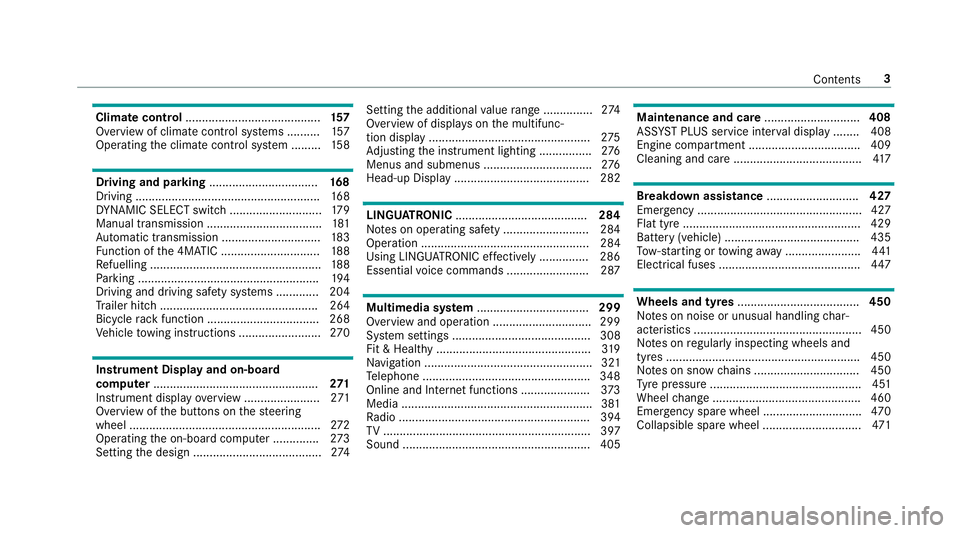
Climate control
......................................... 157
Overview of climate contro l systems ..........1 57
Operating the climate control sy stem ......... 15 8 Driving and pa
rking ................................. 16 8
Driving ........................................................ 16 8
DY NA MIC SELECT switch ............................1 79
Manual transmission ................................... 181
Au tomatic transmission .............................. 183
Fu nction of the 4MATIC .............................. 188
Re fuelling .................................................... 188
Pa rking ...................................................... .194
Driving and driving sa fety sy stems .............2 04
Tr ailer hit ch................................................ 264
Bicycle rack function .................................. 268
Ve hicle towing instructions ........................ .270 Instrument Display and on-board
comp uter.................................................. 271
Instrument display overview ...................... .271
Overview of the buttons on thesteering
wheel ..........................................................2 72
Operating the on-board computer .............. 273
Setting the design ....................................... 274Setting
the additional value range ............... 274
Overview of displa yson the multifunc‐
tion display .................................................2 75
Ad justing the instrument lighting ................2 76
Menus and submenus ................................. 276
Head-up Display ......................................... 282 LI
NG UATRONIC ........................................ 284
No tes on operating saf ety .......................... 284
Ope ration ................................................... 284
Using LINGU ATRO NIC ef fectively ............... 286
Essential voice commands ........................ .287 Multimedia sy
stem .................................. 299
Overview and operation .............................. 299
Sy stem settings .......................................... 308
Fit & Healt hy............................................... 319
Na vigation ................................................... 321
Te lephone .................................................. .348
Online and Internet functions ..................... 373
Media ..........................................................3 81
Ra dio .......................................................... 394
TV ............................................................... 397
Sound ......................................................... 405 Main
tenance and care ............................. 408
ASS YST PLUS service inter val display ........ 408
Engine compartment .................................. 409
Cleaning and care ...................................... .417 Breakdown assistance
............................427
Emergency .................................................. 427
Flat tyre ...................................................... 429
Battery (vehicle) ......................................... 435
To w- starting or towing away ....................... 441
Electrical fuses ........................................... 447 Wheels and tyres
..................................... 450
No tes on noise or unusual handling char‐
acteristics .................................................. .450
No tes on regular lyinspecting wheels and
tyres .......................................................... .450
No tes on snow chains ................................ 450
Ty re pressure .............................................. 451
Wheel change ............................................ .460
Emergency spa rewheel .............................. 470
Collapsible spare wheel .............................. 471 Con
tents 3
Page 12 of 609
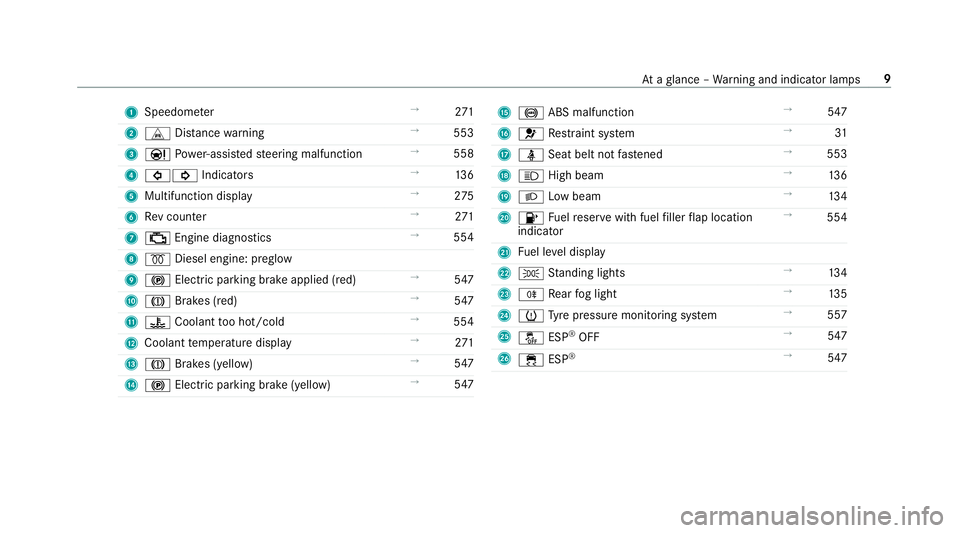
1
Speedom eter →
271
2 L Distance warning →
553
3 00CC Powe r-assis tedsteering malfunction →
558
4 003E003D Indicators →
13 6
5 Multifunction display →
275
6 Rev counter →
271
7 00B9 Engine diagnostics →
554
8 0028 Diesel engine: preglow
9 0024 Electric pa rking brake applied (red) →
547
A 004D Brakes (red) →
547
B 00AC Coolant too hot/cold →
554
C Coolant temp erature display →
271
D 004D Brakes (yell ow) →
547
E 0024 Electric pa rking brake (yellow) →
547 F
0025 ABS malfunction →
547
G 0075 Restra int sy stem →
31
H 00E9 Seat belt not fastened →
553
I 0057 High beam →
13 6
J 0058 Low beam →
13 4
K 00B6 Fuelreser vewith fuel filler flap location
indicator →
554
L Fuel le vel display
M 0060 Standing lights →
13 4
N 005E Rear fog light →
13 5
O 0077 Tyre pressure monitoring sy stem →
557
P 00BB ESP®
OFF →
547
Q 00E5 ESP®
→
547 At
aglance – Warning and indicator lamps 9
Page 14 of 609
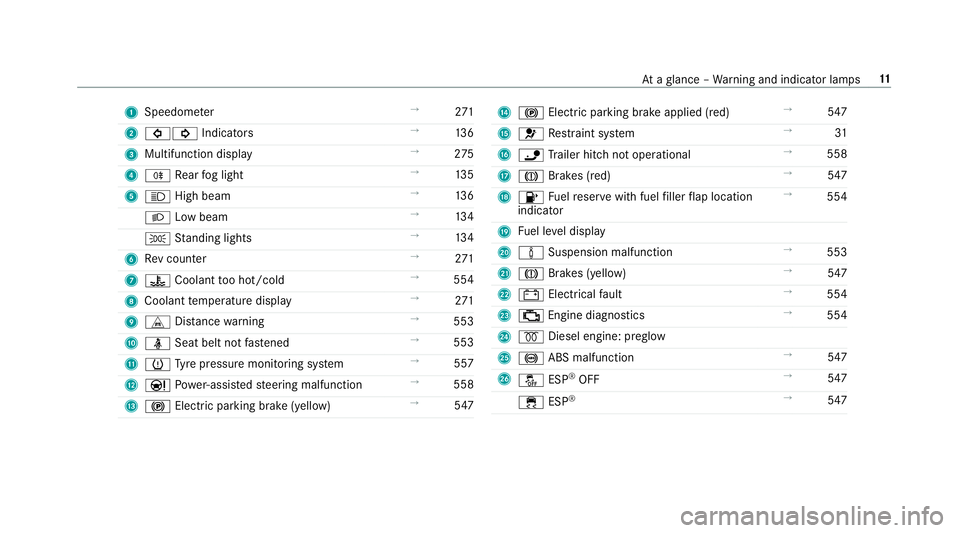
1
Speedom eter →
271
2 003E003D Indicators →
13 6
3 Multifunction display →
275
4 005E Rear fog light →
13 5
5 0057 High beam →
13 6
0058 Low beam →
13 4
0060 Standing lights →
13 4
6 Rev counter →
271
7 00AC Coolant too hot/cold →
554
8 Coolant temp erature display →
271
9 L Distance warning →
553
A 00E9 Seat belt not fastened →
553
B 0077 Tyre pressure monitoring sy stem →
557
C 00CC Powe r-assis tedsteering malfunction →
558
D 0024 Electric pa rking brake (yellow) →
547 E
0024 Electric pa rking brake applied (red) →
547
F 0075 Restra int sy stem →
31
G 00CA Trailer hit chnot operational →
558
H 004D Brakes (red) →
547
I 00B6 Fuelreser vewith fuel filler flap location
indicator →
554
J Fuel le vel display
K 00CC Suspension malfunction →
553
L 004D Brakes (yellow) →
547
M 003D Electrical fault →
554
N 00B9 Engine diagnostics →
554
O 0028 Diesel engine: preglow
P 0025 ABS malfunction →
547
Q 00BB ESP®
OFF →
547
00E5 ESP®
→
547 At
aglance – Warning and indicator lamps 11
Page 22 of 609
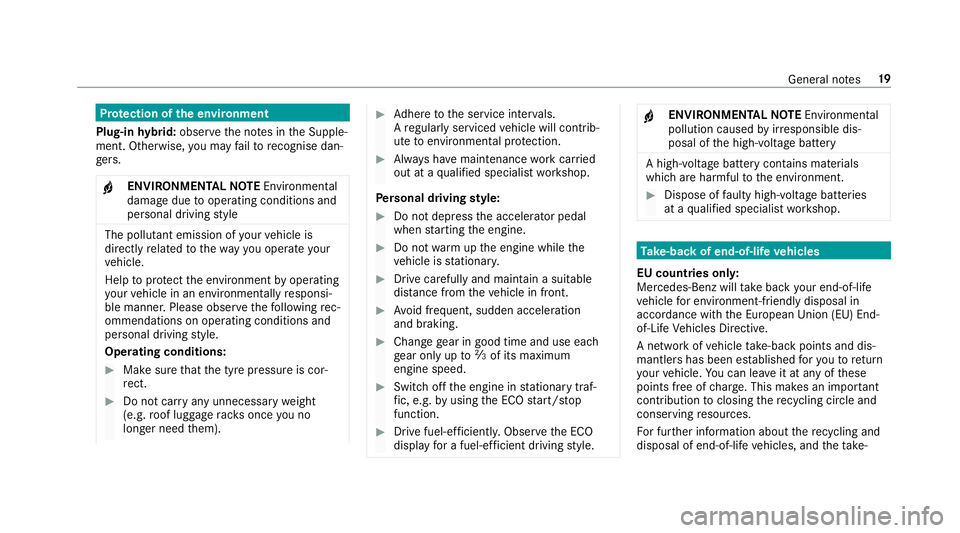
Pr
otection of the environment
Plug-in hybrid: obser vethe no tes in the Supple‐
ment. Otherwise, you may failto recognise dan‐
ge rs.
000F ENVIRONMENTAL
NOTEEnvironmental
dama gedue tooperating conditions and
personal driving style The pollutant emission of
your vehicle is
directly related tothewa yyo u operate your
ve hicle.
Help toprotect the environment byoperating
yo ur vehicle in an environmentally responsi‐
ble manner. Please obser vethefo llowing rec‐
ommendations on ope rating conditions and
pe rsonal driving style.
Operating conditions: 0007
Make sure that the tyre pressure is cor‐
re ct. 0007
Do not car ryany unnecessary weight
(e.g. roof luggage rack s once you no
lon ger need them). 0007
Adhere tothe service inter vals.
A regularly serviced vehicle will contri b‐
ute toenvironmen tal pr otection. 0007
Alw ays ha vemaintenance workcar ried
out at a qualified specialist workshop.
Pe rsonal driving style: 0007
Do not depress the accelera tor pedal
when starting the engine. 0007
Do not warm upthe engine while the
ve hicle is stationar y. 0007
Drive carefully and maintain a suitable
di st ance from theve hicle in front. 0007
Avoid frequent, sudden acceleration
and braking. 0007
Change gear in good time and use each
ge ar on lyup to00C3 of its maximum
engine speed. 0007
Switch off the engine in stationary traf‐
fi c, e.g. byusing the ECO start/ stop
function. 0007
Drive fuel-ef ficiently. Obser vethe ECO
display for a fuel-ef ficient driving style. 000F
ENVIRONMEN
TALNO TEEnvironmental
pollution caused byirre sponsible dis‐
posal of the high-voltage battery A high-voltage battery conta
ins materials
which are harmful tothe environment. 0007
Dispose of faulty high-voltage bat teries
at a qualified specialist workshop. Ta
ke -back of end-of-life vehicles
EU countries onl y:
Mercedes-Benz will take back your end-of-life
ve hicle for environment-friendly disposal in
accordance with the European Union(EU) End-
of-Life Vehicles Directive.
A network of vehicle take -ba ckpoints and dis‐
mantlers has been es tablished foryo uto return
yo ur vehicle. You can lea veit at any of these
points free of charge . This makes an impor tant
contribution toclosing there cycling circle and
conse rving resources.
Fo r fur ther information about there cycling and
disposal of end-of-li fevehicles, and theta ke- Gene
ral no tes 19
Page 30 of 609
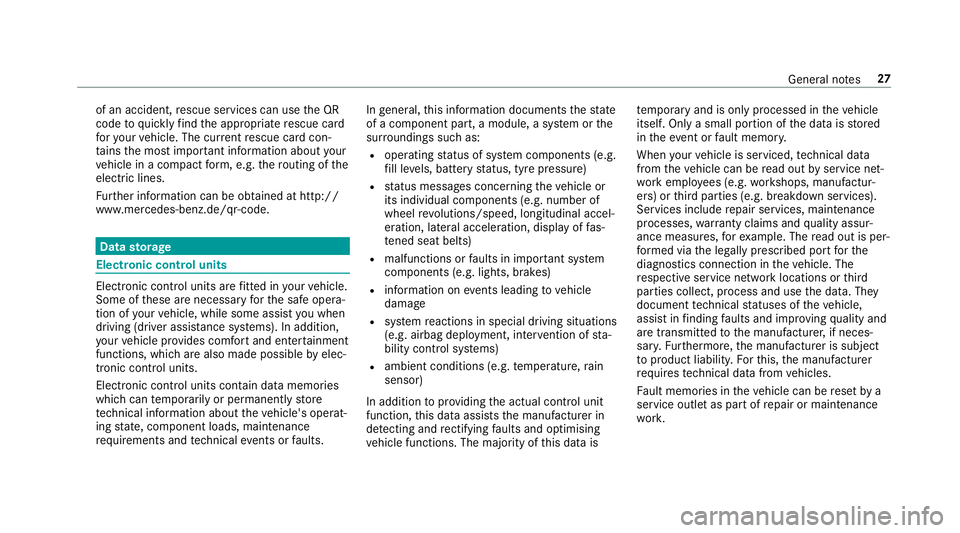
of an accident,
rescue services can use the QR
code toquickly find the appropriate rescue card
fo ryo ur vehicle. The cur rent rescue card con‐
ta ins the most impor tant information about your
ve hicle in a compact form , e.g. thero uting of the
electric lines.
Fu rther information can be obtained at http://
www.mercedes-benz.de/qr-code. Data
storage Electronic control units
Elect
ronic control units are fitted in your vehicle.
Some of these are necessary forth e safe opera‐
tion of your vehicle, while some assist you when
driving (driver assis tance sy stems). In addition,
yo ur vehicle pr ovides com fort and enter tainment
functions, which are also made possible byelec‐
tronic control units.
Elect ronic control units contain da tamemories
which can temp orarily or permanently store
te ch nical information about theve hicle's operat‐
ing state, component loads, main tenance
re qu irements and tech nical events or faults. In
general, this information documents thest ate
of a component part, a module, a sy stem or the
sur roundings such as:
R operating status of sy stem components (e.g.
fi ll le vels, battery status, tyre pressure)
R status messages concerning theve hicle or
its individual components (e.g. number of
wheel revo lutions/speed, longitudinal accel‐
eration, lateral acceleration, display of fas‐
te ned seat belts)
R malfunctions or faults in impor tant sy stem
components (e.g. lights, brakes)
R information on events leading tovehicle
damage
R system reactions in special driving situations
(e.g. airbag deployment, inter vention of sta‐
bility control sy stems)
R ambient conditions (e.g. temp erature, rain
sensor)
In addition toprov iding the actual control unit
function, this data assists the manufacturer in
de tecting and rectifying faults and optimising
ve hicle functions. The majority of this data is te
mp orary and is only processed in theve hicle
itself. Only a small portion of the data is stored
in theeve nt or fault memor y.
When your vehicle is serviced, tech nical da ta
from theve hicle can be read out byservice net‐
wo rkemplo yees (e.g. workshops, manufactur‐
ers) or third parties (e.g. breakdown services).
Services include repair services, maintenance
processes, warranty claims and quality assur‐
ance measures, forex ample. The read out is per‐
fo rm ed via the legally prescribed port forthe
diagnostics connection in theve hicle. The
re spective service network locations or third
parties collect, process and use the data. They
document tech nical statuses of theve hicle,
assist in finding faults and impr oving quality and
are transmitted tothe manufacturer, if neces‐
sar y.Fu rthermore, the manufacturer is subject
to product liability. Forth is, the manufacturer
requ irestech nical da tafrom vehicles.
Fa ult memories in theve hicle can be reset by a
service outlet as part of repair or maintenance
wo rk. Gene
ral no tes 27
Page 194 of 609
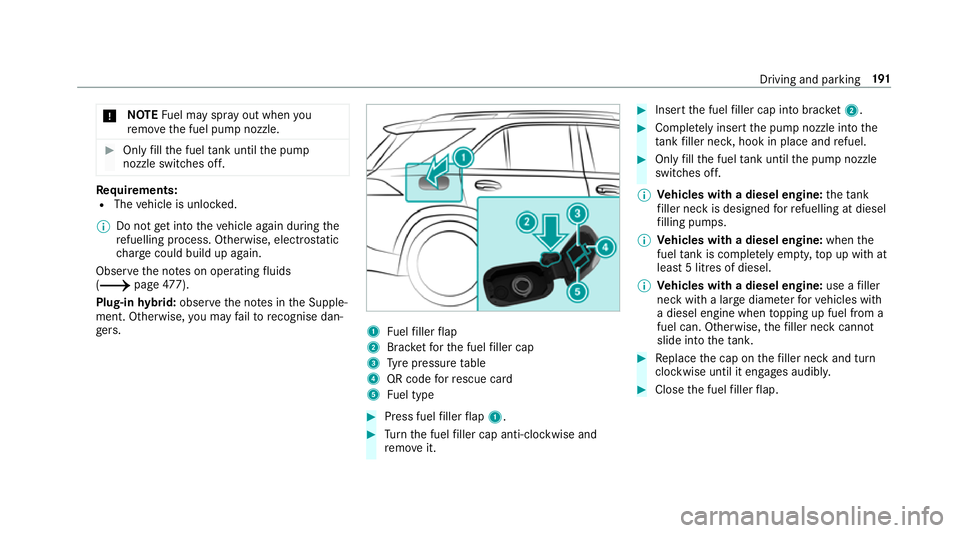
000E
NO
TEFuel may spr ayout when you
re mo vethe fuel pump nozzle. 0007
Only fill th e fuel tank until the pump
nozzle switches off. Re
quirements:
R The vehicle is unloc ked.
0009 Do not get into theve hicle again during the
re fuelling process. Otherwise, electros tatic
ch arge could build up again.
Obser vethe no tes on operating fluids
(0013 page477).
Plug-in hybrid: obser vethe no tes in the Supple‐
ment. Otherwise, you may failto recognise dan‐
ge rs. 1
Fuelfiller flap
2 Brac ketfo rth e fuel filler cap
3 Tyre pressure table
4 QR code forre scue card
5 Fuel type 0007
Press fuel filler flap 1. 0007
Turn the fuel filler cap anti-clockwise and
re mo veit. 0007
Insert the fuel filler cap into brac ket2. 0007
Comp lete ly inse rtthe pump nozzle into the
ta nk filler nec k,hook in place and refuel. 0007
Only fill th e fuel tank until the pump nozzle
switches off.
0009 Vehicles with a diesel engine: theta nk
fi ller neck is designed forre fuelling at diesel
fi lling pumps.
0009 Vehicles with a diesel engine: whenthe
fuel tank is compl etely em pty, top up with at
least 5 litres of diesel.
0009 Vehicles with a diesel engine: use afiller
neck with a lar gediame terfo rve hicles with
a diesel engine when topping up fuel from a
fuel can. Otherwise, thefiller neck cannot
slide into theta nk. 0007
Replace the cap on thefiller neck and turn
clockwise until it engages audibl y. 0007
Close the fuel filler flap. Driving and parking
191
Page 208 of 609
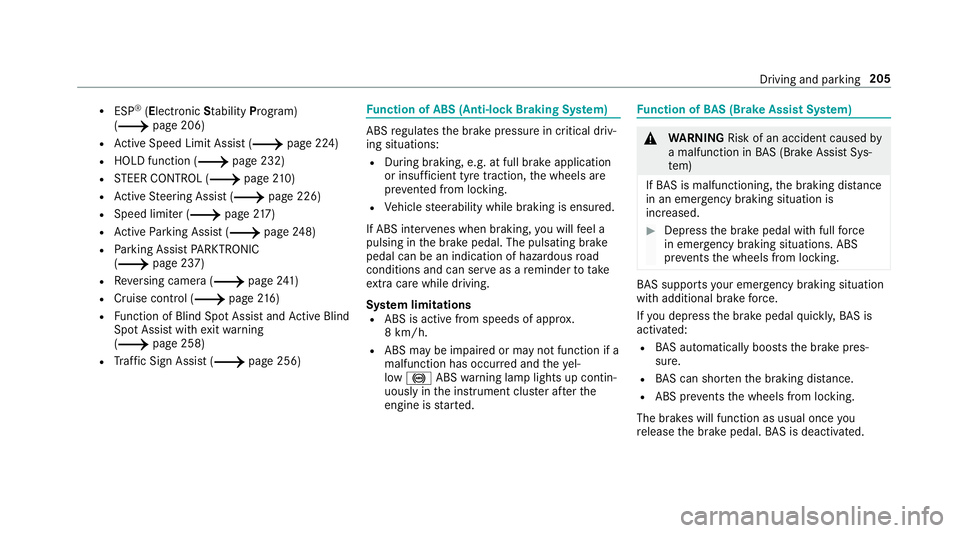
R
ESP ®
(E lectronic Stability Program)
(0013 page 206)
R Active Speed Limit Assi st (0013 page 224)
R HOLD function (0013 page 232)
R STEER CONTROL (0013 page 210)
R Active Steering Assist (0013 page 226)
R Speed limiter (0013 page217)
R Active Parking Assist (0013 page248)
R Parking Assist PARKTRONIC
(0013 page 237)
R Reversing camera (0013 page241)
R Cruise control (0013 page 216)
R Function of Blind Spot Assi stand Active Blind
Spot Assi stwith exitwa rning
(0013 page 258)
R Traf fic Sign Assi st (0013 page 256) Fu
nction of ABS (Anti-lock Braking Sy stem) ABS
regulates the brake pressure in critical driv‐
ing situations:
R During braking, e.g. at full brake application
or insuf ficient tyre traction, the wheels are
pr eve nted from lo cking.
R Vehicle steerability while braking is ensured.
If ABS inter venes when braking, you will feel a
pulsing in the brake pedal. The pulsating brake
pedal can be an indication of hazardous road
conditions and can ser veas a reminder totake
ex tra care while driving.
Sy stem limitations
R ABS is active from speeds of appr ox.
8 km/h.
R ABS may be impai red or may not function if a
malfunction has occur red and theye l‐
low 0025 ABSwarning lamp lights up contin‐
uously in the instrument clus ter af terthe
engine is star ted. Fu
nction of BAS (Brake Assist Sy stem) 000A
WARNING Risk of an accident caused by
a malfunction in BAS (Brake Assi stSys‐
te m)
If BA S is malfunctioning, the braking dis tance
in an emergency braking situation is
increased. 0007
Dep ress the brake pedal with full force
in emer gency braking situations. ABS
pr eve nts the wheels from locking. BA
S suppo rts yo ur eme rgency braking situation
with additional brake forc e.
If yo u depress the brake pedal quickl y,BA S is
acti vated:
R BAS au tomatical lyboosts the brake pres‐
sure.
R BAS can sho rten the braking dis tance.
R ABS pr events the wheels from locking.
The brakes will function as usual once you
re lease the brake pedal. BAS is deactivated. Driving and pa
rking 205
Page 218 of 609
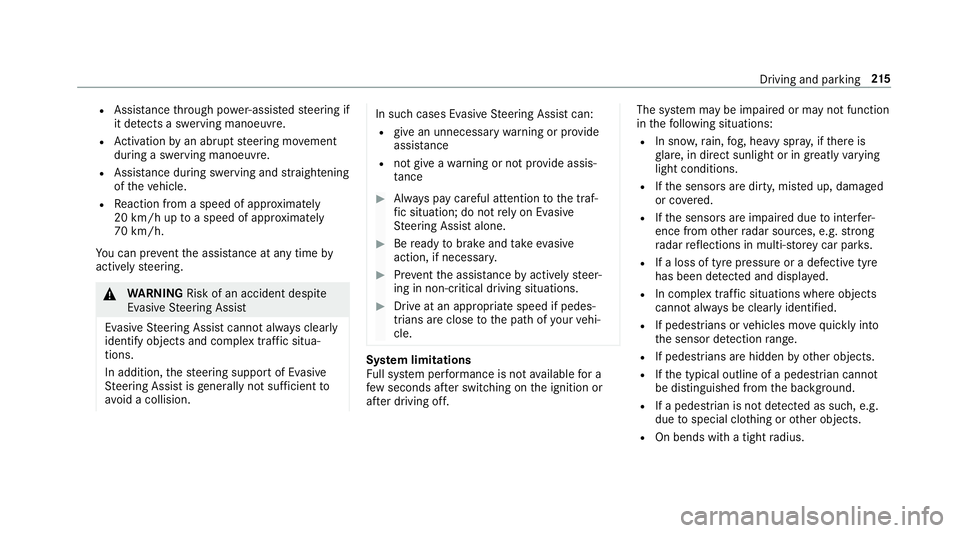
R
Assi stance thro ugh po wer-assis tedsteering if
it de tects a swerving manoeuvre.
R Activation byan abrupt steering mo vement
during a swerving manoeuvre.
R Assis tance du ring swerving and stra ightening
of theve hicle.
R Reaction from a speed of appr oximately
20 km/h up toa speed of appr oximately
70 km/h.
Yo u can pr eventthe assis tance at any time by
actively steering. 000A
WARNING Risk of an accident despi te
Evasive Steering Assist
Evasive Steering Assist cann otalw ays clearly
identify objects and complex traf fic situa‐
tions.
In addition, thesteering support of Evasive
St eering Assist is general lynot su fficient to
avo id a collision. In such cases Evasive
Steering Assist can:
R give an unnecessary warning or pr ovide
assis tance
R not gi veawa rning or not pr ovide assis‐
ta nce 0007
Alw ays pay careful attention tothe traf‐
fi c situation; do not rely on Ev asive
St eering Assist alone. 0007
Beready tobrake and take evasive
action, if necessar y. 0007
Preve ntthe assis tance byactively steer‐
ing in non-critical driving situations. 0007
Drive at an appropriate speed if pedes‐
trians are close tothe path of your vehi‐
cle. Sy
stem limitations
Fu ll sy stem per form ance is not available for a
fe w seconds af ter switching on the ignition or
af te r driving off. The sy
stem may be impaired or may not function
in thefo llowing situations:
R In sno w,rain, fog, heavy spr ay, if there is
gl are, in direct sunlight or in greatlyvarying
light conditions.
R Ifth e sensors are dirty, mis ted up, damaged
or co vered.
R Ifth e sensors are impaired due tointer fer‐
ence from other radar sources, e.g. strong
ra dar reflections in multi-s torey car par ks.
R If a loss of tyre pressure or a defective tyre
has been de tected and displ ayed.
R In complex traf fic situations whe reobjects
cannot always be clearly identified.
R If pedestrians or vehicles mo vequickly into
th e sensor de tection range.
R If pede strians are hidden by other objects.
R Ifth e typical outline of a pedestrian cann ot
be distinguished from the bac kground.
R If a pedestrian is not de tected as su ch, e.g.
due tospecial clo thing or other objects.
R On bends with a tight radius. Driving and parking
215